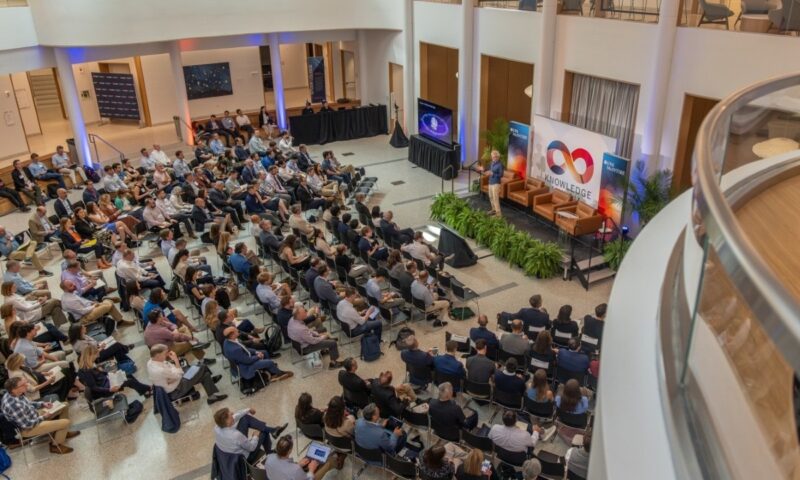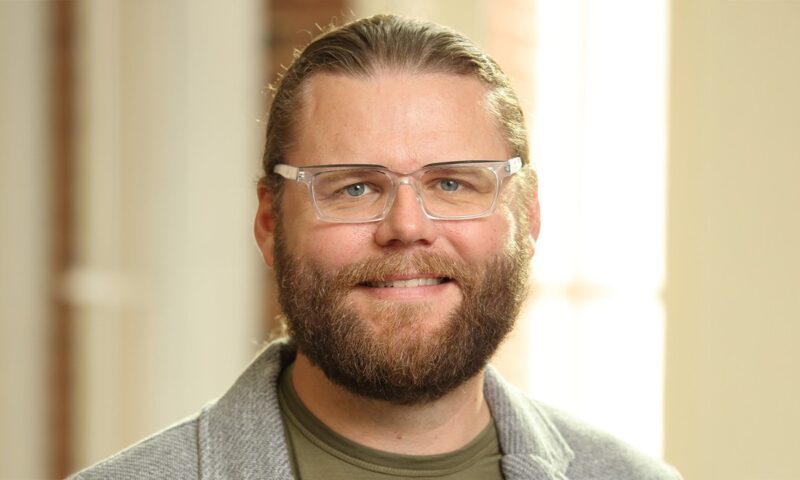Big data. Machine learning. Artificial intelligence. These buzzwords are behind more than industry disruption and reframing how companies stay competitive: These tools are essentially changing our lives. Or as McIntire IT Professor, Associate Dean for Analytics Initiatives, and Director of the Center for Business Analytics Ahmed Abbasi, says, “When we talk about technology and where things are headed, this is going to impact everyone—and it’s already happening.”
At a recent panel on the future of analytics at UVA’s new D.C.-area facilities in Arlington, VA, Abbasi welcomed current students of UVA’s M.S. in Business Analytics Program Katie Feige (A&S ’04, M.S. in Business Analytics ’19), Senior Manager at Capital One, and John Strohecker (Darden ’13, M.S. in Business Analytics ’19), Senior Manager at professional services firm Grant Thornton, to discuss the exciting real-world applications of these technologies and their ability to produce insightful business decisions.
Joining them were Alyssa Guo (McIntire ’08), Director of Business Analytics for applied AI company Afiniti, and Paula Traugh, Senior Manager of HR Insights & Analytics at hospitality giant Hilton, one of the MSBA Program’s corporate partners.
All four professionals gave a candid account of how important analytics has become in their respective roles and the crucial part data plays in empowering these leaders to make better choices for their organizations.
The Human Element
Abbasi began by asking Traugh to share her experiences seeing analytics capabilities mature throughout her organization and the unique challenges she faced working in human resources. She described how Hilton’s HR moved from a model of reporting key metrics quarter by quarter into analytics after a determined investment and focus to facilitate a reliable and quick transition. One of the largest challenges for HR, she said, concerned education about choosing the right metrics and ensuring that stakeholders appreciate their significance.
“Not everyone has the same comfort level with data, so as we went through and redefined and rededicated what our metrics were, we had to excessively socialize all of those definitions,” Traugh explained. “Not only within HR, but also with all of the partners that we support with workforce data. So we’re working with our customer org and our commercial services org, and really helping them understand the value of these metrics.”
The payoff of that initiative to create a sound data foundation manifested in company-wide support for implementing analytics to predict turnover risks and drive engagement. Data is helping team performance, sales, and the company to meet business its objectives. “At the end of the day,” Traugh said, “we’re a company of people serving people, so analytics is at the core as we continue to build that business case and demonstrate that the value of an investment in a human is the value invested in the business.”
Guo stressed that while it’s vital to understand the technical aspects of choosing the right data to build predictive models, it still requires a person’s judgment to succeed. “All of this, in the end, is human,” she said. “With AI, we want to say that it’s automated, but we have an AI engineer behind every single AI model we build. They decide how much data to ingest, what models to build. It is very human.”
Abbasi then delved into an area closely related to the human aspect of analytics, asking Feige and Strohecker to discuss how analytics is helping reimagine the user experience.
Creative visualization is a necessary step for preparing data for senior leaders, Feige said. “They don’t have time to go through layers and layers of data to understand what they’re looking at as we do as analysts. So to be able to put data into a consumable format for executives is something we’re learning through the MSBA Program. It’s invaluable for executives to be able to assess what their benchmarks are, what their goals are, and how they’re doing.”
Strohecker emphasized that it’s also imperative to take a meta-analytical look at the often overwhelming amount of data a company has access to, as introducing an active data-driven approach requires knowing that what’s being measured is actually important.
Taking the Lead
“When you go from data to decisions, it’s always an interesting leap,” Abbasi remarked, surveying the panelists about the factors shaping the professional journey from data analyst to executive leader.
Traugh agreed, adding that leadership is a mindset and that everyone at any level of an organization should be practicing leadership daily. “When you’re transitioning from a true analyst role into leadership, it’s because you’ve already demonstrated those skill sets day in and day out with your peers, managers, and senior leaders in your organization,” she said. “That means questioning, giving feedback, raising ideas, and investing in other people just as much as other people are investing in you.”
For all of those positive habits, Traugh said, within analytics, real leaders “have to be a little bit crazy,” noting that “if someone wasn’t crazy enough to decide that Excel wasn’t good enough,” analytics wouldn’t be the game-changing force it has become. “Someone continually challenged the way things have been done, saying, ‘There’s a better way to evaluate this. There’s a better model we can use. There’s a better approach that we can do to drive impact.’”
Strohecker suggested that shifting from analyst to leader depends on the ability to ask the type of key questions that move an organization forward. “The analysts are the people proposing potential answers,” he said, “but the leader has to be able to understand enough of the work that’s being done that they can then make a determination when they look at three or four different solutions to decide which is the best fit.”
To be effective in that decider role, he added, “you may not have to be an expert, but you have to understand enough of the science behind it that you can make an intelligent decision. The evolution from analyst to leader is more about being able to focus more on the forest and less on the trees.”
Bridging the Gap
Feige was already a team leader when she moved into a role collaborating with tech teams—and where analytics suddenly became increasingly important. “I had the Excel base, but I didn’t have SQL, Python, or R,” she said. “That’s what I needed to move forward, and as I’m learning all of these, I’m able to communicate what I’m learning in the MSBA Program to work with data scientists.”
She was quick to point out how the MSBA Program had proven beneficial to her work and that she draws from the subject matter every day. “I use it in both talking to data scientists and talking to leaders. It’s just unbelievably impressive how we can use these real-life business cases and apply them to things that we’re doing. I work in HR, and I can do it, so anybody can do all of these things,” Feige said, adding that she’s also been able to assist her husband with his projects in cybersecurity with her new knowledge.
Strohecker, a leader with extensive experience overseeing technical teams, stressed that while analytics offers the ability to track virtually any variable, it’s crucial to maintain a focus on the organization’s goals throughout the process.
“I’ve got a team of about 85 folks who work for me—and that includes data analytics and performance management—all of whom are focused on providing feedback to a government agency. When I can see what my data analytics team is doing in SQL and tell them it’s not the right way to do it or ask them to let me take a look at their entity relationship diagram so I can get a sense of how it’s structured—immediately—even if I’m not the person sitting down behind the keyboard, they know I’m somebody who understands enough of what they’re doing,” Strohecker said.
With the MSBA coursework informing his growing skill set, Strohecker is free to suggest tools his teams may have overlooked by mere force of habit; the increased expertise he’s gained from the MSBA Program offers him a clear advantage.
“So infrequently is someone in a leadership position with a technical team that they actually understand what’s going on, as opposed to having to trust what they’re handed because they simply can’t ferret out the noise from the signal,” he said. “By understanding a little bit more about the discipline and the art of the possible, you can start to expand the horizons of the team by asking them to try new approaches.”



